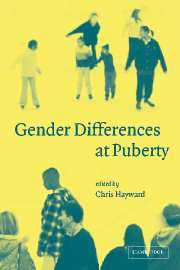Book contents
- Frontmatter
- Contents
- List of figures
- List of tables
- List of contributors
- Preface
- Acknowledgments
- 1 Methodological concerns in puberty-related research
- Part 1 Sex differences in hormones and their effect at puberty
- Part 2 Girls at puberty
- Part 3 Boys at puberty
- Part 4 Puberty and psychopathology
- Part 5 Pubertal timing: antecedents
- Part 6 Pubertal timing: consequences
- Part 7 Puberty and context
- 14 Puberty in context
- Index
- References
14 - Puberty in context
Published online by Cambridge University Press: 22 September 2009
- Frontmatter
- Contents
- List of figures
- List of tables
- List of contributors
- Preface
- Acknowledgments
- 1 Methodological concerns in puberty-related research
- Part 1 Sex differences in hormones and their effect at puberty
- Part 2 Girls at puberty
- Part 3 Boys at puberty
- Part 4 Puberty and psychopathology
- Part 5 Pubertal timing: antecedents
- Part 6 Pubertal timing: consequences
- Part 7 Puberty and context
- 14 Puberty in context
- Index
- References
Summary
Examinations of links between pubertal development and various outcomes (e.g., psychopathology, reproductive behaviors) have focused on both the effects of puberty on behavior as well as on how context and behavior influence the course of puberty. The interest in puberty as a defining transition in the course of development is in many ways based on circumstantial evidence. That is, rates of psychopathology change dramatically in the late pubertal to postpubertal period for several common disorders, such as depression and conduct disorder (e.g., Lewinsohn, et al., 1993; Loeber and Keenan, 1994). In addition, gender differences in rates of depression also emerge at this time (see chapter 8). The challenge to researchers interested in developmental process and the health outcomes of adolescents has been to demonstrate that some link or links actually exist between pubertal development and these behavioral and adjustment changes. Furthermore, if such links exist to what extent are they explanatory in rates of psychopathology in adolescence and to what extent do they identify strategies for prevention and intervention for adolescent mental health.
Historically, it has long been assumed that puberty was an important causal element in adolescent adjustment and behavior. This “assumption” is no small factor in our understanding of adolescent development and prevention and intervention for mental health. Although Buchanan and her colleagues (Buchanan, Eccles, and Becker, 1992) attempted to lay to rest the notion of “raging hormones” in their now classic review of the hormone and behavior literature prior to 1992, the reality is that most parents, teachers, and even adolescents themselves believe that raging hormones exist and that they explain behavior.
- Type
- Chapter
- Information
- Gender Differences at Puberty , pp. 307 - 325Publisher: Cambridge University PressPrint publication year: 2003
References
- 30
- Cited by



